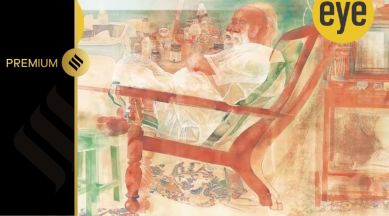How do artists see themselves? An exhibition in the city reveals
Delhi’s Gallery Threshold celebrates 25 years with self-portraits by leading contemporary artists

How does an artist visualise the self? There can be no linear perspective, much like an artwork that is open to interpretation. While several artists have painted self-portraits over centuries — from Vincent van Gogh to Frida Kahlo, Amrita Sher-Gil and Pablo Picasso — when Delhi-based gallerist Tunty Chauhan was pondering ways to mark 25 years of Gallery Threshold, she decided to rely on self-portraits as a means of celebration and introspection. “We always exhibit works that artists create, not necessarily looking inwards but their perception of what they see. A self-portrait is more about how they see themselves,” says Chauhan, “It is also ties together so many diverse artistic practices.”
The outcome is an assemblage of 35 artists represented in the exhibition “Reflecting the Self” through self-portraits — if in some instances we see glaring images of them staring at viewers, in others places their appearance is more fleeting and at times they draw from memories to share moments from the past. If Gulammohammed Sheikh’s Ghosts, Demons and Sundry Souls of Solace brings together a multitude of influences and reflections, including Mahatma Gandhi as well as demons from the past, Sudhir Patwardhan brings himself before the audience in self-portraits painted over the years, from 1972 to 2023. Krishen Khanna’s macabre self-portrait is painted in oil and Anju Dodiya’s Masking series has the artist beneath the mask, concealing as much as she reveals. Manisha Gera Baswani has pulled out a silhouette from her photograph of Manjunath Kamath for her triptych Ek Dastaan. “It’s my portrait looking at my life that has been, through the many hearts I have painted. We live through our lives resplendent in our hearts and yet there are days you feel this is not a good day and you look forward to the next,” says Baswani.
monthly limit of free stories.
with an Express account.
Regarded as a pioneering printmaker, in this exhibition Anupam Sud turns to fibreglass for the set of self-portraits titled Traces. In the suite of works, she presents herself in different garbs, from her head covered with a scarf to her bust encrusted in golden colour. V Ramesh’s 3×7 feet Self Portrait in the Studio with a Single Malt has him on a rocking chair with the paraphernalia of his studio, looking out at a jasmine creeper. He takes inspiration from the renowned miniature The Dying Inayat Khan. “To get one’s whole world into something — sometimes it’s possible, other times it’s not,” says Ramesh.
Not all is what it appears to be and it is up to the viewers to excavate layers beneath the imagery. In Jyoti Bhatt’s 1966 photograph Ardhnarishwar, clicked in Venice, we see reflections of his wife and artist Jyotsna Bhatt’s face and his torso in a mirrored image. Anindita Bhattacharya’s set of 12 works Wandering the night sky through moonlit aches juxtaposes x-rays depicting the anatomy of rescued animals, layered with drawings and incisions made on paper. In her note, she writes, “I attempt a multifaceted self-portrait that transcends my own visage, embracing the lives that are an integral part of my every day and the intricate threads that weave us all together.”
Meanwhile, Rahul Inamdar leaves his canvas blank, reflective of the prolonged time artists spend contemplating their work. A tag marks words such as ‘Endless’, ‘Empty’ and ‘Quiet’. The artist says, “If I look at my own practice, there is a long period of waiting before I make any work… I feel that in the life of an artist, the longest time is spent before a blank canvas. It seemed like a timeless and most honest portraiture of myself.”